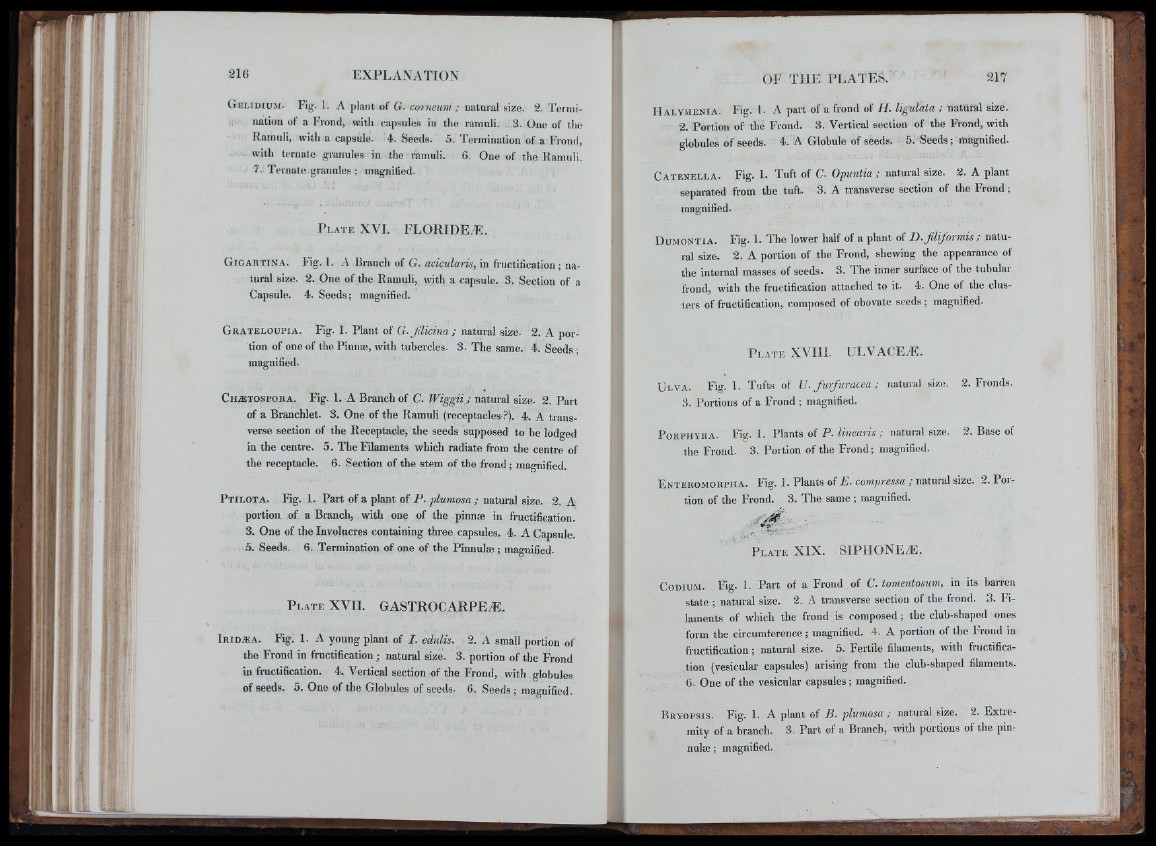
G e l id iu m . Fig. 1. A plant of G. corneum ; natural size. 2. Termination
of a Frond, with capsules in the ramuli. 3. One of the
Ramuli, with a capsule. 4. Seeds. 5. Termination of a Frond,
with ternate granules in the ramuli. 6. One of the Ramuli.
7. Ternate granules ; magnified.
P l a t e XVI. FLORIDEÆ.
G ig a r t in a . l*ig. 1. A Branch of G. acicularisfm fructification; natural
size. 2. One of the Ramuli, with a capsule. 3. Section of a
Capsule. 4. Seeds; magnified.
G r a t e l o u p ia . Fig. 1. Plant of G.Jilicina; natural size. 2. A portion
of one of the Pinnæ, with tubercles. 3. The same. 4. Seeds ;
magnified.
C hæ to s po r a . Fig. 1. A Branch of 0. Wiggii ; natural size. 2. Part
of a Branchlet. 3. One of the Ramuli (receptacles-?). 4. A transverse
section of the Receptacle, the seeds supposed to be lodged
in the centre. 5. The Filaments which radiate from the centre of
the receptacle. 6. Section of the stem of the frond ; magnified.
P t il o t a . Fig. 1. Part of a plant of P. plumosa; natural size. 2. A
portion of a Branch, with one of the pinnæ in fructification.
3. One of the Involucres containing three capsules. 4. A Capsule.
5. Seeds. 6. Termination of one of the Pinnulæ ; magnified.
P l a t e XVII. GASTROCARPEÆ.
I r id æ a . Fig. 1. A young plant of I. edulis. 2. A small portion of
the Frond in fructification ; natural size. 3. portion of the Frond
in fructification. 4. Vertical section of the Frond, with globules
of seeds. 5. One of the Globules of seeds. 6, Seeds ; magnified.
H a l y m e n ia . Fig. 1. A part of a frond of H. ligulata ; natural size.
2. Portion of the Frond. 3. Vertical section of the Frond, with
globules of seeds. 4. A Globule of seeds. 5. Seeds ; magnified.
C a t e n e l l a . Fig. 1. Tuft of C. Opuntia ; natural size. 2. A plant
separated from the tuft. 3. A transverse section of the Frond ;
magnified.
D u m o n t i a . Fig. 1. The lower half of a plant of D. filiformis ; natural
size. 2. A portion of the Frond, shewing the appearance of
the internal masses of seeds. 3. The inner surface of the tubular
frond, with the fructification attached to it. 4. One ot the clusters
of fructification, composed of obovate seeds ; magnified.
P l a t e XVIII. ULVACEAi.
U l v a . Fig. 1. Tufts of U. furfuracea; natural size. 2. Fronds.
3. Portions of a Frond ; magnified.
P o r p h y r a . Fig. 1. Plants of 2k ¿¿nearw ; natural size. 2. Base of
the Frond. 3. Portion of the Frond; magnified.
E n t e r o m o r p h a . Fig. 1. Plants of E- compressa ; natural size. 2. Portion
of the Frond. 3. The same ; magnified.
P l a t e XIX. SIPHONEÆ.
C o d iu m . Fig. 1. Part of a Frond of C. tomentosum, in its barren
state ; natural size. 2. A transverse section of the fi ond. 3. Filaments
of whicii the frond is composed ; the club-shaped ones
form the circumference ; magnified. 4. A portion of the Frond in
fructification ; natural size. 5. Fertile filaments, with fructification
(vesicular capsules) arising from the club-shaped filaments.
6. One of the vesicular capsules ; magnified.
B r yo p s is . Fig. 1. A plant of B. plumosa; natural size. 2. Extremity
of a branch. 3. Part of a Branch, with portions of the pinnulæ
; magnified.